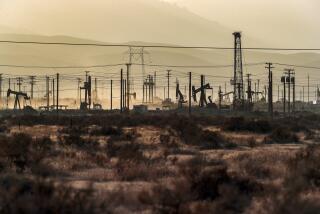‘Clean’ coal power plants a far-off goal
- Share via
WASHINGTON -- — At a bend in the Ohio River, a bulky new device is being attached to a 30-year-old coal plant near the small town of New Haven, W.Va.
The device is being housed in a building four stories tall and bigger than a football field. A 150-foot-tall exhaust stack -- so wide that it would take six adults with their arms fully stretched to reach around it -- will reach into the sky. And pipelines will run out of the building and into saline aquifers two miles underground. The entire contraption will start up as early as September.
The purpose: capturing carbon dioxide emissions and stashing them in underground rock formations -- a crucial part of the global effort to slow climate change. This is the technique that promoters say will make coal “clean” and critics say is an expensive pipe dream.
The stimulus package devoted $2.4 billion to pilot projects. On Monday, the Obama administration awarded $20 million of that to a program that uses supersonic shock waves to compress carbon for storage, on top of $408 million in stimulus money awarded to two other carbon pilot projects. It has pledged $1 billion more to a model plant called FutureGen.
If the Waxman-Markey climate bill becomes law, a new Carbon Storage Research Corp. would pump an additional $1.1 billion a year into researching this nascent technology, and first movers would get billions of dollars more in bonus emission allowances that could be sold.
Coal companies and environmentalists alike are counting on a breakthrough in carbon capture and storage technology to siphon off harmful emissions from the world’s coal plants. Coal plants account for a third of U.S. greenhouse emissions. In the last five years, China has brought on line coal-fired electricity equal in size to total U.S. installed capacity, and new plants are starting up in the developing world regularly. Without a breakthrough on coal plants, it may be impossible to meet emission limits climatologists say are needed.
Yet carbon capture and storage remains the Holy Grail of the coal industry, an idea that could contain the damage inflicted by coal-burning power plants but a technology that remains expensive, energy intensive and largely untested. Even optimists say it will not be commercially available for six to 10 more years. Pessimists say it might take much longer and may never be ready for widespread use without attaching a punishingly high price to carbon.
“There is no credible pathway towards prudent greenhouse gas stabilization targets without CO2 emissions reduction from existing coal power plants,” Ernest Moniz, a professor at the Massachusetts Institute of Technology and a member of President Obama’s Council of Advisors on Science and Technology, said in a report this year. “We urgently need technology options for these plants and policies that incentivize implementation.”
Coal “is still the elephant in the room,” John Ashton, special representative for climate change at Britain’s Foreign and Commonwealth Office, said at a meeting in Washington last month. “We can’t deal with it; we can’t tame it without . . . carbon capture and storage.”
He said that to meet the newly agreed-upon target of limiting global warming to 2 degrees, nations must make carbon capture “standard technology by 2020.”
The West Virginia plant belongs to American Electric Power Co., an electric utility that is the largest consumer of coal in the United States. Said Michael Morris, chief executive of AEP, “Clearly carbon capture and storage is essential for a company like AEP, and I would argue equally essential for the United States, because you can’t go through the process of prematurely shutting down half the supply base of the American utility industry.”
But the AEP project illustrates the tremendous obstacles ahead. As big as it is, the equipment there will capture the emissions from only 20 megawatts of power generation, a meager 15% of the plant’s output. Morris’ predecessors were smart enough to buy lots of extra land at the West Virginia plant, but other coal plants would have trouble finding room.
The big capture device, built by France’s Alstom, would take the exhaust of the plant after the coal is burned and “bubble” it through a solution of chilled ammonia. The CO2 would bond with the ammonia and be separated from other gases. Then the carbon dioxide would be separated from the ammonia and compressed for storage.
The huge carbon capture and storage devices are hugely expensive too. AEP executives estimate that the cost of carbon capture for a modest-size coal plant of about 235 megawatts would start at $700 million. That works out to about $100 for a ton of carbon dioxide, far above the projections made by the Environmental Protection Agency about prices under a cap-and-trade scheme similar to one passed by the House in June. MIT put the cost of carbon capture and storage at $50 to $70 a ton. (The Waxman-Markey bill would give the first six gigawatts of plants -- equal to about seven average-size plants -- a $90-per-ton subsidy in the form of free allowances.)
Capture-and-storage devices also require large amounts of energy. The Alstom approach uses about 15% of the power plant’s energy output; other processes use as much as 30%. That means the utility must buy other energy sources to cover the shortfall. (The energy lost is part of the $700-million cost, AEP executives said.)
As a result, many experts say countries would be better off retrofitting old coal plants or replacing them with new, more efficient ones. Retrofits could result in emission reductions of 4% to 5%, MIT said in its study. More-costly replacements of older plants could cut more than a quarter of their emissions.
More to Read
Sign up for Essential California
The most important California stories and recommendations in your inbox every morning.
You may occasionally receive promotional content from the Los Angeles Times.













